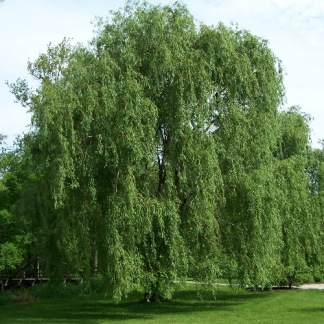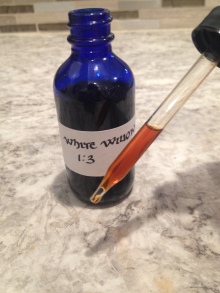
Yesterday, I woke up in excruciating pain. Lately, I’ve been adopting some awkward sleeping positions due to the intense heat we’ve been experiencing. It is in some kind of desperate, subconscious attempt to flatten my body and thereby increase the surface area over which any miniscule breeze might flow that I have managed to wrench my neck in a most devastating fashion. In other words: I slept funny and now I can’t turn my neck.

- Dried bark of the White Willow tree
Awhile back, I tinctured up some White Willow Bark I’d purchased from Mountain Rose Herbs. White Willow, a.k.a. Salix alba, has a long tradition of use as a painkiller. Its dried bark is, in fact, the original source of Bayer’s aspirin. The primary pain-killing ingredient is salicin, which is converted by the gut into saligenin, which is then metabolized to salicylic acid, the active ingredient in Aspirin (you will see it on the label as “acetyl” salicylic acid).
There are pros and cons to taking White Willow instead of straight Aspirin. The main pro is that it also contains a large amount of tannins, which protect your stomach from the notorious irritation caused by over-the-counter pain killers, like Aspirin. Additionally, White Willow seems to have a lesser effect on coagulation than Aspirin (Altinterim, 2013). In other words, Aspirin thins your blood, and White Willow doesn’t, at least not to the same degree. In most cases, blood thinning is not a desirable side effect. Your body needs to be able to form platelets and clot the blood in order to heal cuts, for example.
The main con of White Willow Bark is that it takes much longer to experience any effect. It has to be metabolized into the salicylic acid and re-absorbed before any analgesic effects can be noted. This can take an hour or more.
But, in the name of SCIENCE, I elected to try the Willow Bark and put it to the test. I took two dropperfuls in water and waited an hour. Nothing, I tell you. NOTHING. And my tincture is fairly strong. It is a 1:3 ratio of Willow Bark to grain alcohol. (The standard ratio for Willow Bark extract is typically 1:4). I decided to consult my girl Dr. Marisa Marciano, the Naturopathic Herbalist, for dosing recommendations. She recommends 5-8 mL three times per day. Two dropperfuls is about 2-3 mL. So… I NEEDED MORE. I went ahead and took three more dropperfuls in water (about 5 mL, or another teaspoon-I was getting desperate).

That did the trick. About 45 minutes later, I noticed my shoulders had relaxed and I reached for my son to pick him up without thinking twice. I ran a vacuum, lifted baskets of laundry (I am SO domestic, aren’t I?), and got on with my day. The pain relief lasted quite a while, too. About 8 hours passed before I felt I needed another dose. This herb seems to abide by the old Aesopian moral of “slow and steady wins the race.” Nicely played, White Willow.
I am very excited to try this one for my neck pain!!😊
LikeLike
I recommend it, Beth! Remember, though, that it WILL take longer to “kick in,” and don’t take straight aspirin along with it! While it is extremely difficult to overdose on White Willow or Aspirin, it CAN happen. So just take one or the other, never both at the same time. Thanks again so much for reading, and let me know how the White Willow works for you!!
LikeLike
Great post! I’ve been looking for an effective alternative to the usual painkillers, as stomach irritation is a consistent problem for me. I’ll give this a try!
LikeLike